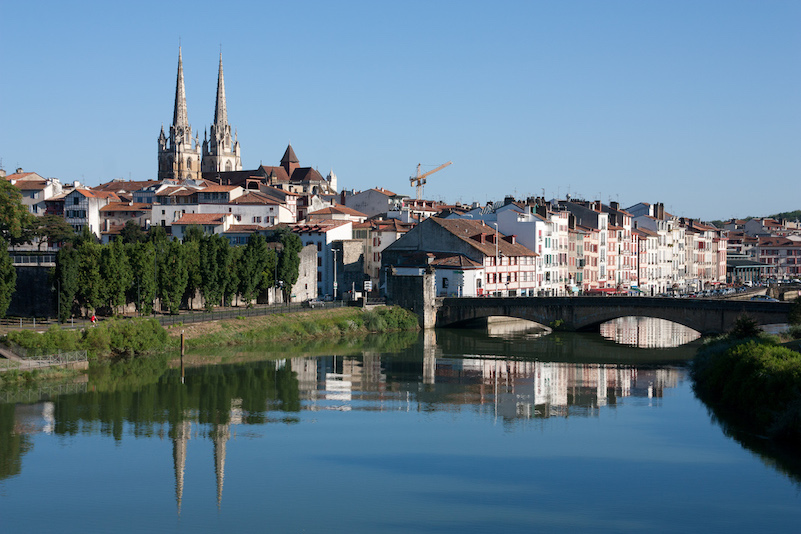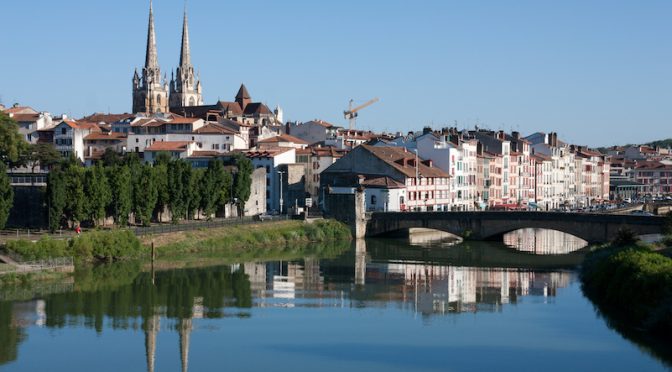Baiona, or Bayonne as it is known in French and English, is one of the jewels of the coast of Iparralde. A historically important port, it was a thriving economic center during various phases of its history. It has also changed hands many times, being part of the Kingdom of Pamplona, England, and France over the centuries. As a consequence, it has a long and complex history; I’m only scratching the surface here.

- Baiona, with its motto numquam polluta (“never soiled”), is the capital of the province of Lapurdi – located at the confluence of the Nive (Errobi in Euskara) and Adour (Aturri) rivers – and over its history has been a religious, administrative, and military center. The urban center is divided into three parts linked by bridges that reflect its history: Gran Baiona, which is the ancient Roman nucleus; the medieval barrio of Little Baiona; and Saint-Esprit.
- Almost certainly, the place we now call Baoina was long inhabited before the Romans reached the area. But, in the 1st century, the Romans built a wall around the city to keep out the Tarbelli, Aquitani, or the proto-Basque. The Romans built a fort or castrum named Lapurdum – though this may have also been the name of the larger territory – from which the name of the province came from.
- After the fall of the Roman Empire, the Romans left the city in the 4th century and control alternated between the Vascones – ancestors to our modern Basques – and the English. In 1023, the viscounty of Lapurdi, part of the Kingdom of Pamplona, was created and Baiona was the capital. Baiona proper was established in 1056 when Raymond II the Younger, Bishop of Bazas, was tasked with building the Church of Bayonne. It wasn’t much later when the town abandoned the name Lapurdum and began being referred to as Baiona in official documents.
- In 1152, Eleanor of Aquitaine married Henry II of England, placing the city under English rule. Her son, Richard I Lionheart, became Duke of Aquitaine and thus Baiona was directly ruled by the kings of England. This opened the English market to local products and Baiona became an important commercial hub and military base. Baiona’s economy was centered around shipbuilding and whaling. Further, in about 1174, Richard declared the fueros of Baiona, formalizing the rights of the citizens of the town.
- During the time of English rule, multiple factions arose in Baiona, allied with different powers, leading to myriad conflicts. In one infamous incident, Pes de Puyane, the then mayor of Baiona, placed guards to collect tolls on one of the bridges. The locals threw the guards in the river, teasing them to check the height of the water. Puyane retaliated by taking five men and hanging them from the bridge, asking them to check the water levels as the water rose and ultimately drowned the men.
- In 1451, Jean de Dunois, onetime comrade of Joan of Arc, captured the city for the French crown. It was about this same time that the Spanish Inquisition was persecuting Jews, many of whom fled to Baiona, bringing their recipes for chocolate with them. However, the loss of English markets and rights to the French crown (for example, the mayor was now appointed by the king, not elected by the citizens of Baiona) led to economic decline in the city. In 1602, by request of the merchants of Baiona who were threatened by the economic competition they posed, the King of France ordered the expulsion of the Jewish inhabitants of the city.
- In the 17th century, during the constant fighting that occurred in the French countryside, the peasants of Baiona, lacking gunpowder and ammunition, began fixing knives to the ends of their muskets, creating the bayonet (though the Chinese were using something similar even earlier).
Primary sources: Estornés Zubizarreta, Idoia. Baiona. Historia. Auñamendi Encyclopedia. Available at: https://aunamendi.eusko-ikaskuntza.eus/en/baiona-historia/ar-10193/; Bayonne, Wikipedia
Discover more from Buber's Basque Page
Subscribe to get the latest posts sent to your email.



Thanks for these articles and linking even more history to them for me to read. I learn so much from them! I never knew Richard the Lionhearted had a connection to the Basque area and Baiona. Thank you again.
Glad you enjoy them Scott! There is so much history to chase, it becomes almost impossible to keep track of it all. 🙂
Aye, it is like an electron in quantum mechanics!
😉
Ha! That might be a lot easier to understand. 🙂
The bayonet comes from Baiona?!?!?! 🤯 Well now I feel the Basque-pride need to go edit the Wikipedia article for bayonet. the article for Bayonne describes it, but not the one for bayonet and I feel like that needs rectifying, lol.